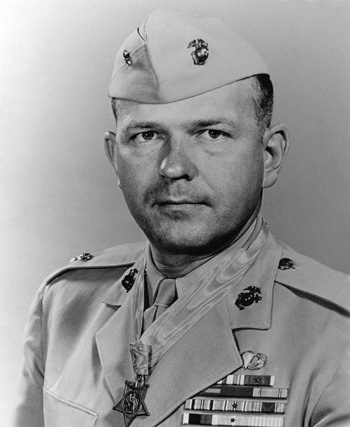
|
William E. Barber |
 |
|||
| Rank, Service | ||||
Colonel O-6, U.S. Marine Corps |
||||
| Veteran of: | ||||
|
||||
| Tribute: | ||||
William Barber was born on November 20, 1919, in Dehart, Kentucky. He enlisted in the U.S. Marine Corps on March 14, 1940, and after completing basic training and parachutist school, he served as an instructor in the Parachute Training School at San Diego, California, and at Camp Lejeune, North Carolina, from March 1942 until he entered Officer Candidate School at MCS Quantico, Virginia, in June 1943. He was commissioned a 2d Lt in the Marine Corps on August 11, 1943, and then attended the Reserve Officers Class at Quantico from August to October 1943. After additional training, Lt Barber served with E Company, 2nd Battalion, 26th Marine Regiment, 5th Marine Division at Camp Pendleton, California, from January 1944 to January 1945, and then deployed to the Pacific Theater from January 1945 to October 1945, where he participated in the Battle of Iwo Jima in February and March 1945. After returning to the U.S., Capt Barber served with the 5th Engineering Battalion of the 5th Marine Division in San Diego, California, until transferring to the 2nd Engineering Battalion of the 2nd Marine Division in late November 1945, serving there until January 1946. His next assignment was as a training officer at MCRD San Diego from March to April 1946, followed by service as a recruiting officer in Milwaukee, Wisconsin, from April to November 1946. He served as Commanding Officer of B Company, 1st Battalion, 8th Marine Regiment, 2nd Marine Division, at Camp Lejeune from November 1946 to September 1947, and then served as an instructor with the U.S. Marine Corps Reserve in Altoona, Pennsylvania, from September 1947 to September 1949. Capt Barber next served at Naval Base Philadelphia, Pennsylvania, from September 1949 to October 1950, and then served with 2nd Battalion, 7th Marine Regiment, 1st Marine Division in Korea from October 1950 until he was evacuated for his injuries during the Battle of Chosin Reservoir in December 1950. He was hospitalized in Japan until returning to the U.S. in March 1951, and then served with the 1st Recruit Training Battalion at MCRD San Diego from April 1951 to August 1953. Maj Barber next attended the Advanced Infantry Course at Fort Benning, Georgia, from August 1953 to March 1954, followed by service with 2nd Battalion, 2nd Marine Division at Camp Lejeune from April 1954 to January 1956. After completing Strategic Intelligence School, he served as Assistant Naval Attache and Assistant Naval Attache for Air in Bangkok, Thailand, from March 1956 to August 1958, and then served as an instructor at the Marine Corps Schools at Quantico from October 1958 to June 1962. Col Barber next served as Commander of 3rd Recon Battalion, 3rd Marine Division on Okinawa from July 1962 to April 1963, and then as Executive Officer of the 9th Marine Regiment, 3rd Marine Division from April to July 1963. He then received an assignment to complete his Bachelor's degree from September 1963 to May 1964, followed by service at Headquarters U.S. Marine Corps in the Pentagon from June 1964 to July 1967. Col Barber's next assignment was on the staff of the 2nd Marine Division from July 1967 to February 1968, and then as Commanding Officer of the 2nd Marine Regiment, 2nd Marine Division at Camp Lejeune from February 1968 to May 1969. His final assignment was as Psychological Operations Officer for III Marine Amphibious Force in South Vietnam from June 1969 to March 1970. Col Barber retired from the Marine Corps on May 1, 1970. He died on April 19, 2002, and was buried at Arlington National Cemetery. |
||||
|
||||

